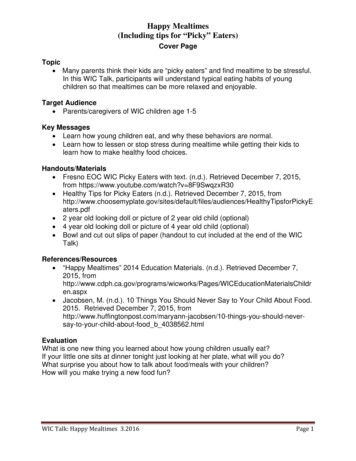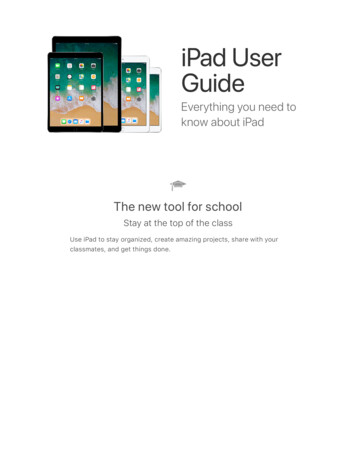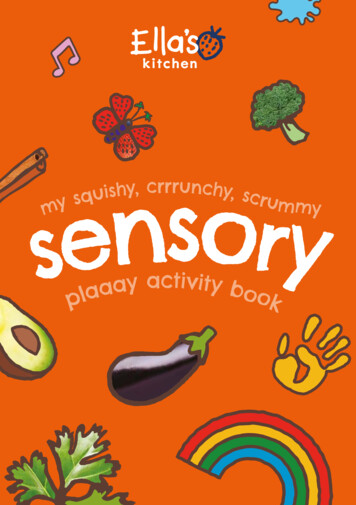
Transcription
Happy Mealtimes(Including tips for “Picky” Eaters)Cover PageTopic Many parents think their kids are “picky eaters” and find mealtime to be stressful.In this WIC Talk, participants will understand typical eating habits of youngchildren so that mealtimes can be more relaxed and enjoyable.Target Audience Parents/caregivers of WIC children age 1-5Key Messages Learn how young children eat, and why these behaviors are normal. Learn how to lessen or stop stress during mealtime while getting their kids tolearn how to make healthy food choices.Handouts/Materials Fresno EOC WIC Picky Eaters with text. (n.d.). Retrieved December 7, 2015,from https://www.youtube.com/watch?v 8F9SwqzxR30 Healthy Tips for Picky Eaters (n.d.). Retrieved December 7, 2015, es/audiences/HealthyTipsforPickyEaters.pdf 2 year old looking doll or picture of 2 year old child (optional) 4 year old looking doll or picture of 4 year old child (optional) Bowl and cut out slips of paper (handout to cut included at the end of the WICTalk)References/Resources “Happy Mealtimes” 2014 Education Materials. (n.d.). Retrieved December 7,2015, /WICEducationMaterialsChildren.aspx Jacobsen, M. (n.d.). 10 Things You Should Never Say to Your Child About Food.2015. Retrieved December 7, 2015, -food b 4038562.htmlEvaluationWhat is one new thing you learned about how young children usually eat?If your little one sits at dinner tonight just looking at her plate, what will you do?What surprise you about how to talk about food/meals with your children?How will you make trying a new food fun?WIC Talk: Happy Mealtimes 3.2016Page 1
Happy Mealtimes(Including tips for “Picky” Eaters)Topic OverviewThe following summarizes open ended questions used during the group session that follows. Thesecan also be used during individual education to facilitate the discussion around this topic. Offerhandouts listed on the cover page.OPEN: Emotion-based education starts with provocative questions, activities or stories that leadto emotion-based conversations, not to an immediate transfer of knowledge.IntroductionsIcebreaker: Have participants introduce themselves and start with strengths:“What do YOU do to make mealtimes with your family enjoyable?DIG: During the "dig" step, the facilitator asks questions to get the learners to open up, share theirmemories and experiences, and get closer to the topic.Is your child a “picky eater”? Which of these describes your child?CONNECT: During the "connect" step, parents connect the conversation topic with their values,attitudes, beliefs and feelings. The facilitator helps parents reflect on their personal needs andwants and connects them to the health-related behaviors being suggested.“Does it surprise you that all these things kids do are normal?” Wait for responses. “Why orwhy not?” or “Tell me more.”“Why do you think your child is doing these things?” “What can you do encourage your child toeat healthfully?ACT: During this “step” the facilitator helps the participants identify specific action steps andbuild confidence to help them be the parents they want to be.Offer handout on Healthy Tips for Picky Eaters, such as the one listed on page one under“References/Resources”. Give parents time to look over the tips.“Which of these things do you already do with your family?”EvaluationWhat is one new thing you learned about how young children usually eat?If your little one sits at dinner tonight just looking at her plate, what will you do?What surprise you about how to talk about food/meals with your children?How will you make trying a new food fun?WIC Talk: Happy Mealtimes 3.2016Page 2
Happy Mealtimes(Including tips for “Picky” Eaters)Group EducationOPEN: Emotion-based education starts with provocative questions, activities or storiesthat lead to emotion-based conversations, not to an immediate transfer of knowledge.Introductions: Introduce yourselfo State how long the session will be (should be less than 30 minutes) andintroduce the topic and key messages.“We’ll talk about if your child is a picky eaters, or normal. And we’ll look atsome tips to make meals less stressful and still help our kids eathealthier.”Icebreaker: Have participants introduce themselves and start with strengths:o “What do YOU do to make mealtimes with your family enjoyable?Turn to your neighbor and share one thing you do to make familymealtimes pleasant.”(Wait for parents to share with each other, and then invite parents to sharetheir responses with the group.)DIG: During the "dig" step, the facilitator asks questions to get the learners to open up,share their memories and experiences, and get closer to the topic.Is Your Child a Picky Eater or a Normal Eater?EXPLORE: “We know that mealtimes can be hard sometimes. I’m going to read somethings that your child may or may not do, and I invite you to raise your hand for eachone if it describes your child.”Read the following list. Wait after each one for parents to raise their hands. (You maywish to raise your own hand on some of these, to encourage parents to respond.)“My child makes a mess with her food.”“My child will not sit still for long.”“My child doesn’t like to try new foods.”“My child only wants to eat one kind of food.”“My child doesn’t want to eat what I serve – she wants something else.”“My child doesn’t eat much.”“My child sometimes doesn’t want to eat anything.”“My child used to eat everything, but now he only eats a few things.”“My child eats a lot one day and not much the next day.”WIC Talk: Happy Mealtimes 3.2016Page 3
Happy Mealtimes(Including tips for “Picky” Eaters)Offer: “Most young kids do at least some of these things. It can be frustrating andstressful, and we worry when our kids don’t eat the way we think they should.”So, it’s good to know that all of these things that we might call “picky eating” arecompletely normal for young children!”CONNECT: During the "connect" step, parents connect the conversation topic withtheir values, attitudes, beliefs and feelings. The facilitator helps parents reflect on theirpersonal needs and wants and connects them to the health-related behaviors beingExplore: “Does it surprise you that all these things kids do are normal?” (Wait forresponses). “Why or why not?” or “Tell me more.”“Why do you think your child is doing these things?”Sample Responses They are learning about foods. They’re exploring how foods look, feel, smell and taste. They are becoming more independent, and they like to make decisions forthemselves. They are testing limits and seeing what your reaction is. They are growing more slowly than they did before, so they don’t need to eat asmuch.Picky Eating Video Clip or HandoutOffer: Show the video clip lisited on page one under “Handouts/Materials” or offer thehandout, “Healthy Tips for Picky Eaters”, as listed on page one under“Handouts/Materials”. It is also enclosed as a SSM as part of this WIC Talk.This video (or handout) introduced some great ideas on how to work with your child tomake sure they are eating as healthfully as they can for their age. It suggests tryingnew foods in small portions and including your child in making meals.What do you think about these ideas?What ideas did you like the best?Sample Responses (from video) Let your child pick out fruits and vegetables at the grocery store or plant your owngarden. Include your child in meal preparation.o Young children can do simple things like rinsing off the vegetables, addingsimple ingredients or stirring food. Turn off the TV and enjoy family time during meal time. Offer choice but don’t make a different meal for each child.o If you have multiple children, let each child choose one night for the familymeal.WIC Talk: Happy Mealtimes 3.2016Page 4
Happy Mealtimes(Including tips for “Picky” Eaters) Try new foods in small portions.Set an example by eating healthy foods yourself. Talk to your kids about new foodsyou tried. Describe how it tasted, smelled and how much you liked it.Offer only 1 new food at a time.Serve them something they like with a new food they have never tried before.Other ideas (optional): Boundaries: Most kids want sweet treats but if they are taught that these goodies aresometimes foods and not something they have every day, they will accept eating thisway. Consistency: You can’t allow cupcakes and brownies for snack every day one weekand then tell your child to eat apples and oranges the next. Have fun:-Create a puppet show: For example: if you “feed” their favorite toy a healthyvegetable and pretend that the toy loves it, they are more likely to eat it.-Make up a story: For example create a story about super hero vegetables, eachwith a unique super power to teach about the importance of vegetables.ACT: During this “step” the facilitator helps the participants identify specific actionsteps and build confidence to help them be the parents they want to be.If you didn’t offer it earlier, offer handout/SSM on Healthy Tips for PickyEaters,(mentioned above). Give parents time to look over the tips.EXPLORE:“Which of these things do you already do with your family?”Wait for responses. “Now think about something you might like to try at home.”Wait for a moment while parents think. “If you’d like, turn to your neighbor and share.”Wait for parents to share with each other, and then invite parents to share theirresponses with the group.OFFER:“There are some things you can say to your kids about food that are helpful, and somethat are not as helpful”. [Optional Activity #1: Cut out the “Many Say” and “Instead”statements and place them in a bowl (included at the end of this WIC talk)]. Choose avolunteer to pick the slip out one at a time. Choose a few to facilitate a groupdiscussion. Optional Activity #2: Do a pair and share: Pair participants up with one“Many Say” and “Instead” statement slip each, and have them discuss before facilitatingthe discussion with the larger group].1. Common Statement: "See, your (sister, brother, cousin, friend) is eating it, whydon't you?" Why do you think you shouldn’t you say something like this?Sample Response:Translation: "He/she is a better eater than me."WIC Talk: Happy Mealtimes 3.2016Page 5
Happy Mealtimes(Including tips for “Picky” Eaters)Instead try: "I know you'll get there. It takes time and many tastes to learn to like a newfood. "Why do you think this would be better to say?”Sample Response:This will instill confidence that the child can and will like the food in their own time.Here are some other examples of what parents have said, how it might be translated,better approaches, and why. [You can just state the examples below or facilitate adiscussion (like above) if you prefer].2. "You used to like blueberries -- you are so picky!"What child may hear: "Maybe I won't grow out of this picky-eating thing?"Instead: Don't call attention to picky eating. Instead, make eating an enjoyableexperience.Rationale: Avoid labeling children as "picky" as this is a normal stage of developmentand the label tends to stick.3. "For the last time, no, you cannot have ice cream!"What child may hear: "I'm never getting ice cream again!"Instead: "We are not having ice cream now because lunch is a half hour away. We'llhave some one day this week for dessert."Rationale: Children accept "no" much better when they know why they can't havesomething and when they will have it again.4. "You didn't eat enough. Take a few more bites and then you can leave thetable."What child may hear: "Mom/dad/empty plate (anything else) is a better judge of whenI'm done eating than what I'm feeling inside."Instead say: "Make sure you got enough to eat because the next meal won't be until(breakfast, lunch, dinner, snack time)."Rationale: When children are in charge of how much to eat, they learn how to managehunger (hint: sometimes, mistakes have to be made).5. "If you eat some of your veggies, you can have dessert."What child may hear: "I can't wait until the day I don't have to eat my veggies -- and cango straight to dessert!"Try: Instead of nagging and food rewarding, offer tasty vegetables often and modelhealthy eating.Rationale: Studies show that children learn to prefer the reward food over the "have toeat" food.6. "Good job!" (after eating more than usual)WIC Talk: Happy Mealtimes 3.2016Page 6
Happy Mealtimes(Including tips for “Picky” Eaters)What child may hear: "Mommy and daddy are proud of me when I eat more food orfinish my plate."Instead say: "You always do a good job eating when you listen to your tummy."Rationale: Complimenting children for eating more food teaches them how much theyeat is more important than following their appetite, which is different from meal to meal.7. "Eat this, it's good for you."What child may hear: "It tastes bad."Instead say: "This tastes really good and is similar to X that you like."Rationale: Studies show taste rules what food kids like, and it helps for them to getmore information about a new item.8. "If you’re good in the store, you may have a cookie," or "If you don't stop doingthat, you won't get ice cream tonight."What child may hear: "Every time I'm good, I should get a treat!"Instead: Let them know ahead of time what that will happen if they misbehave -- andleave food out of it.Rationale: There may be long-term effects of rewarding with food. (For example, in a2003 study published in Eating Behaviors), adults who remembered food being used toreward and punish were more likely to binge eat and diet.9. "We don't eat cake often because it is bad for you."What child may hear: "I like everything that is bad for me (Bad pleasure)."Instead say: "Cake is not a food we eat all the time. We'll have some cake this weekendat Jake's birthday party."Rationale: Calling food “good" or "bad" may cause children to feel judged. Instead,teach children how all foods can fit and some foods are “sometimes” foods and someare “anytime” foods.10. "You don't like dinner? Want me to make you something else?"What child may hear: "I never have to venture out with food because mom/dad willalways make my favorites!"Instead say: "We all get the same meal for dinner; sometimes you get your favorite, andother nights someone else does."Rationale: Eating meals together teaches children eating is a family event and getsthem to like more variety of food over time.“What (about these statements) stood out or surprised you? (Wait for responses).“It is very common to for parents to say some of the “common” statements. (You mayoffer your personal experience). If you’ve found yourself or your family using theWIC Talk: Happy Mealtimes 3.2016Page 7
Happy Mealtimes(Including tips for “Picky” Eaters)“common statements”, think of it as an opportunity. With practice, and knowing why it’sa good idea, you can start talking about food differently.”Evaluation:Explore: Read the following scenarios to parents/caregivers. Give parents time to thinkof ideas and respond. Add any sample responses not already shared.“Here’s a little girl, Maria. [(May use prop from Handouts/Material section: show pictureor doll of a 4 year old girl (optional)] Maria is 4 years old. She usually eats dinner byherself while watching TV. Mom decides how much Maria should eat. When Mariasays she is full, Mom says “eat everything on your plate”. What could Maria’s mom dodifferently? Think about what we talked about today, and your own experience.Sample Responses: Eat dinner together as a family Turn off the TV Let Maria decide how much to eat and stop when she is full.“Here’s a little boy, Shawn. Shawn is 2 years old. [(May use prop fromHandouts/Material section: show picture or doll of a 2 year old boy (optional)]. He usedto eat everything. Now he only wants peanut butter and jelly sandwiches and milk. Andsome meals he doesn’t eat much at all. He does drink a lot of milk and juice betweenmeals. What could Shawn’s parents do differently? Think about what we talked abouttoday, and your own experience.”Sample Responses: Let him have peanut butter and jelly sandwiches and milk but keep offering otherfoods too Offer him water in a cup between meals when he is thirsty He may be eating less because he is growing more slowly now.“We talked about some ways our kids eat that make us worry and make mealtimestressful. We also talked about how things that seem like picky eating are totally normalfor young kids, so we shouldn’t stress about them.”What is one new thing you learned about how young children usually eat?If your little one sits at dinner tonight just looking at her plate, what will you do?What surprise you about how to talk about food/meals with your children?How will you make trying a new food fun?WIC Talk: Happy Mealtimes 3.2016Page 8
Happy Mealtimes(Including tips for “Picky” Eaters)Optional Activity: Cut these statements out, fold them up and put them in a bowl. Havevolunteers pick one out and read it to facilitate a group discussion.Many say: See, your (sister,brother, cousin, friend) iseating it, why don't you?Instead say: I know you'll getthere. It takes time and manytastes to learn to like a newfood.Many say: You used to likeblueberries. You are sopicky!Instead: Don't call attentionto picky eating. Instead,make eating an enjoyableexperience.Many say: For the last time,no, you cannot have icecream!Instead say: We are nothaving ice cream nowbecause lunch is a half houraway. We'll have some oneday this week for dessert.Many say: You don't likedinner? Want me to makeyou something else?Instead say: We all get thesame meal for dinner;sometimes you get yourfavorite, and other nightssomeone else does.Many say: You didn't eatenough. Take a few morebites and then you canleave the table.Instead say: Make sureyou got enough to eatbecause the next mealwon't be until (breakfast,lunch, dinner, snack time).Many say: If you eatsome of your veggies, youcan have dessert.Try: Instead of naggingand food rewarding, offertasty vegetables often andmodel healthy eating.Many say: Eat this, it'sgood for you.Instead say: This tastesreally good and is similar toX that you like.Many say: If you’re good inthe store, you may have acookie," or "If you don't stopdoing that, you won't get icecream tonight."Instead: Let them knowahead of time what that willhappen if they misbehave -and leave food out of it.Many say: "Good job!"Many say: We don't eat(after eating more thancake often because it is badusual)for you.Instead say: You alwaysInstead say: Cake is not ado a good job eating when food we eat all the time.you listen to your tummy.We'll have some cake thisweekend at Jake's birthdayparty.WIC Talk: Happy Mealtimes 3.2016Page 9
Happy Mealtimes(Including tips for “Picky” Eaters)Self-Study ModuleProcedureAgencies must follow WIC policies for using SSM (see WIC PPM Nutrition Educationfor details).Method1. Review together or instruct the participant to read the handouts and complete theSSM, “Healthy Tips for Picky Eaters”2. Ask participant if she would like to talk with a CHP about the information or if she hasany questions.WIC Talk: Happy Mealtimes 3.2016Page 10
Healthy TipsforPicky EatersDo any of the statements below remind you of your child?“Ebony will only eat peanut butter sandwiches!”“Michael won’t eat anything green, just because of the color.”“Bananas used to be Matt’s favorite food, now he won’t even touch them!”Your child may eat only a certain type of food or refuse foods based on a certain color or texture. They may also play atthe table and may not want to eat. Don’t worry if your child is a picky eater. Picky eating behavior is common for manychildren from the age of 2 to 5 years. As long as your child has plenty of energy and is growing, he or she is most likelyeating enough to be healthy. If you have concerns about your child’s growth or eating behavior, talk to your child’s doctor.How to cope with picky eatingYour child’s picky eating is temporary. If you don’t make it a big deal, it will usually end before school age. Try thefollowing tips to help you deal with your child’s picky eating behavior in a positive way. Check the ones that work foryou and your child.Let your kids be “produce pickers.” Let them pick out fruitsand veggies at the store.Have your child help you prepare meals. Children learnabout food and get excited about tasting food when they help make meals. Let themadd ingredients, scrub veggies, or help stir food.Offer choices. Rather than ask, “Do you want broccoli for dinner?”ask “Which would you like for dinner, broccoli or cauliflower?”Enjoy each other while eating family meals together.Talk about fun and happy things. If meals are times for family arguments, your childmay learn unhealthy attitudes toward food.Offer the same foods for the whole family.Don’t be a “short-order cook,” making a different meal for your child.Your child will be okay even if he or she does not eat a meal now and then.United States Department of AgricultureFNS-455USDA is an equal opportunity provider and employer.Revised May 2012
Trying new foodsYour child may not want to try new foods. It is normal for children to reject foodsthey have never tried before. Here are some tips to get your child to try new foods:Small portions, big benefits. Let your kids try small portionsof new foods that you enjoy. Give them a small taste at first and be patientwith them. When they develop a taste for more types of foods, it’s easierto plan family meals.Let them learn by serving themselves.Teach them to take small amounts atfirst. Tell them they can get moreif they are still hungry.Offer only one new food at a time. Serve something thatyou know your child likes along with the new food. Offering morenew foods all at once could be too much for your child.Be a good role model. Try new foods yourself.Describe their taste, texture, and smell to your child.Offer new foods first. Your child is most hungryat the start of a meal.Sometimes, new foods take time.They learn from watching you. Eat fruitsand vegetables and your child will too.Kids don’t always take to new foods right away. Offer new foods many times. It may take up to a dozen triesfor a child to accept a new food.Make food fun!Help your child develop healthy eating habits by getting him or her involved and making food fun! Get creative in thekitchen with these cool ideas. Check the ones you try at home, and be sure to add your own ideas, too!Cut a food into fun and easy shapes with cookie cutters.Encourage your child to invent and help prepare newsnacks. Create new tastes by pairing low-fat dressings or dips with vegetables.Try hummus or salsa as a dip for veggies.Name a food your child helps create.Make meals and memories together.It’s a lesson they’ll use for life.Make a big deal of serving “Maria’s Salad” or “Peter’s Sweet Potatoes”for dinner.Our family ideas to make food fun:For more great tips on theseand other subjects, go to:ChooseMyplate.gov/preschoolers/
Consejos Saludablespara los Caprichososcon la Comida¿Alguna de las afirmaciones siguientes le recuerda a su hijo?“¡Ebony sólo come sándwiches de mantequilla de cacahuate (maní)!”“Michael no come nada verde, sólo por el color.”“Los plátanos solían ser la comida favorita de Matt, ¡ahora ni siquiera los toca!”Puede ser que su hijo coma sólo ciertos tipos de alimentos o que rechace alimentos por tener cierto color o textura. Puedeser que también jueguen en la mesa y no quieran comer. No se preocupe si su hijo es quisquilloso con la comida. Elcomportamiento caprichoso con la comida es común en muchos niños de 2 a 5 años de edad. Mientras su hijo tengasuficiente energía y esté creciendo, es muy probable que él o ella esté consumiendo lo suficiente para mantenerse saludable.Si tiene alguna preocupación acerca del crecimiento o el comportamiento alimenticio de su hijo, hable con el médico de su hijo.Cómo lidiar con los caprichos al comerLos caprichos al comer de su hijo son temporales. Si no les da mucha importancia, terminarán generalmente antes de laedad escolar. Pruebe los siguientes consejos para ayudarle a lidiar con el comportamiento caprichoso con la comida de suhijo de una manera positiva. Marque los que funcionen para usted y su hijo.Deje que sus hijos sean “recolectores de frutas y vegetales.”Permítales escoger las frutas y vegetales en la tienda.Haga que su hijo le ayude a preparar las comidas.Los niños aprenden acerca de la comida y se entusiasman para probar los alimentoscuando ayudan a preparar la comida. Permítales añadir ingredientes, lavar verduras,o ayudar a mezclar la comida.Ofrezca opciones. En lugar de preguntar “¿Quieres cenar brócoli?”, pregunte“¿Qué quieres cenar, brócoli o coliflor?”Disfruten de la compañía mutua mientras comen en familia.Hable acerca de temas felices y divertidos. Si las comidas son momentos paradiscusiones familiares, su hijo puede adoptar una actitud poco saludable hacia la comida.Ofrezca la misma comida a toda la familia. No sea un “cocinerode comida rápida,” preparando una comida distinta para su hijo. Su hijo estará bien aún si élo ella no come de vez en cuando.United States Department of AgricultureFNS-455-SUSDA es un proveedor y empleador que ofrece igualdad de oportunidades.Revisado Mayo del 2012
Probar alimentos nuevosPuede ser que su hijo no quiera probar alimentos nuevos. Es normal que los niños rechacencomida que nunca antes han probado. Estos son unos consejos para convencer a su hijo aprobar alimentos nuevos:Porciones pequeñas, grandes beneficios. Permita que sushijos prueben porciones pequeñas de alimentos nuevos que usted disfrute. Deleuna probadita primero y sea paciente con ellos. Cuando desarrollen un gusto pormás tipos de alimentos, es más fácil planear las comidas familiares.Ofrezca sólo un nuevo alimento a la vez. Sirva algo queusted sepa que le gusta a su hijo junto con la comida nueva. Ofrecer másalimentos nuevos a la vez puede ser demasiado para su hijo.Deje que aprendan a servirse ellosmismos. Enséñeles a tomar porcionespequeñas al principio. Dígales quepueden servirse más si aún tienenhambre.Dé un buen ejemplo. Pruebe nuevos alimentos por símismo. Describa su sabor, textura y olor a su hijo.Ofrezca los alimentos nuevos primero.Su hijo tiene más hambre al inicio de la comida.Ellos aprenden de su ejemplo. Coma frutas yverduras y su hijo también lo hará.Algunas veces, toma tiempo adaptarse alos nuevos alimentos. A los niños no siempre les gustan los alimentos nuevos enseguida. Ofrezca comidasnuevas muchas veces. Puede tomarle muchos intentos antes de que un niño acepte un alimento nuevo.¡Haga que la comida sea divertida!¡Ayude a su hijo desarrollar hábitos saludables de comida haciendo que participe y haciendo la comida divertida! Sea creativoen la cocina con estas ideas geniales. Marque las que intenta en su casa, ¡y asegúrese de añadir sus propias ideas también!Corte los alimentos en formas fáciles y divertidas concortadores de galletas.Anime a su hijo a inventar y ayudar a preparar nuevosbocadillos. Cree sabores nuevos combinando aderezos o dips bajos en grasa converduras. Pruebe con hummus (paté de garbanzo) o salsa como dip para verduras.Preparen comidas y construyanrecuerdos juntos. Es una lecciónque les servirá de por vida.Ponga nombre a la comida que su hijo le ayudea crear. Concédale gran importancia al hecho de servir “la ensalada deMaría” o “las batatas de Peter” a la hora de la cena.Ideas de nuestra familia para hacer la comidadivertida:Para recibir más consejos en este yotros temas, visite:ChooseMyplate.gov/preschoolers/
Happy Mealtimes (Including tips for “Picky” Eaters) WIC Talk: Happy Mealtimes 3.2016 Page 6 Instead try: "I know you'll get there. It takes time and many tastes to learn to like a new food. "Why do you think this would be better to say?” Sample Response: This will instill confidence tha










